Last week, I talked about just what stress actually is. This week, you're going to learn about what stress does to our muscles, tendons, joints, and nerves. I'll list the three most common painful conditions that are caused by stress and provide some information on what you can do about it if you're suffering with those conditions.
First, there's a little bit of background you need to have. Many of us have probably heard about our fight, flight, freeze system. Our nervous system is broken down into three categories.
The autonomic nervous system is the part that is most affected by stress. This system is broken down into two parts, the sympathetic nervous system and the parasympathetic nervous system.
The sympathetic nervous system is what is normally referred to as our fight or flight system and the parasympathetic nervous system is often referred to as the rest and digest system.
The sympathetic and parasympathetic systems are both always online in your body. However, if you're walking through the woods and a bear jumps out and starts chasing you, your parasympathetic nervous system will dial way down in function, and your sympathetic nervous system will turn way up. The sympathetic nervous system is meant to protect us from danger. However that system is meant to only be on full blast for short periods of time.
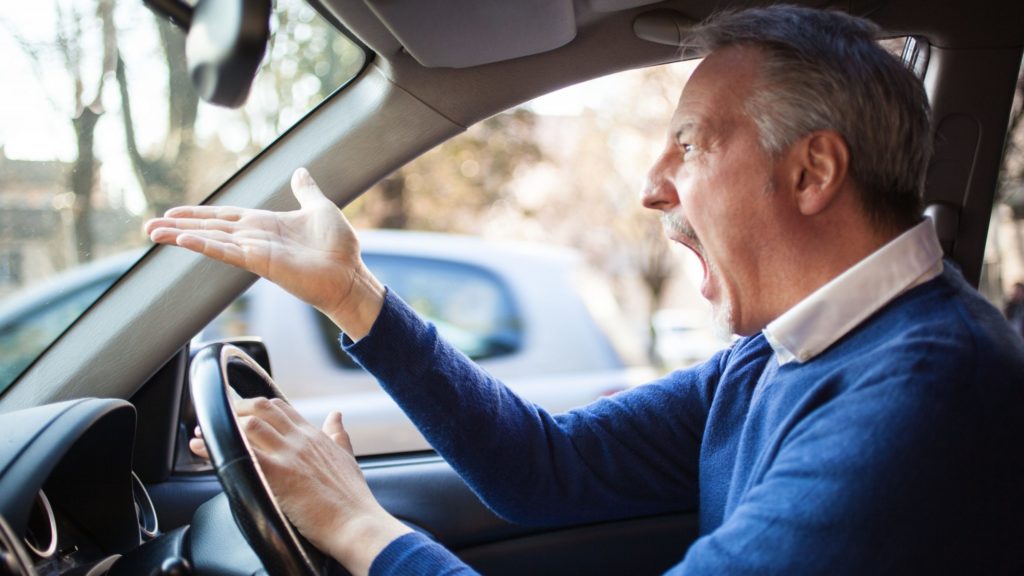
Normally, if that bear jumps out in the woods, the sympathetic nervous system shoots up to overdrive, pumps more blood to your muscles so you can run faster, and usually within 5 to 10 minutes - it's over, one way or the other. You either got away from the bear or you didn't, but either way, the system then is meant to go back to normal.
But we sit in traffic stressed to the max for hours at a time.
And during that time our sympathetic nervous system is running continuously.
That's where the problems occur.
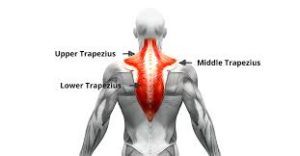
Our bodies can function pretty well with increased activation to those muscles for a short period of time. But if it continues day after day in our stressful lives, then it starts to cause problems. It starts to cause pain and tension on both sides of the neck, it can cause shoulder problems due to the fact that this raises the shoulder from its normal resting position and makes it more vulnerable, and it can cause pain in between the shoulder blades from the tension of all those muscles.
2. The second most common musculoskeletal consequence of increased stress is pain in the jaw. It is very common that when people are under stress, they will clench their jaw as a compensatory strategy. This constant tension can create pain in the muscles surrounding the jaw as well as pain in the jaw joint itself.
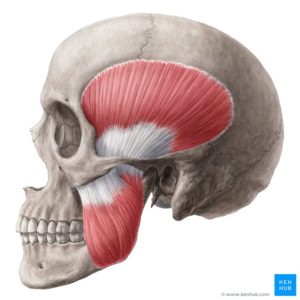
But clenching the jaw is not only a problem for the jaw itself. The way that the muscles in our head and neck work, when you clench your jaw, you clench your neck. So not only does teeth/jaw clenching lead to pain in the jaw, but it can also lead to neck pain as well as headaches. The type of headaches that it causes are referred to as tension headaches. These headaches are felt at the base of your skull and around the sides of your head.

3. The third most common musculoskeletal issue caused by stress is low back pain. The jaw is not the only area that people clench when they are stressed. There are two other areas that are very common for people to clench during times of stress. These are the abdominal muscles and the gluteal muscles.

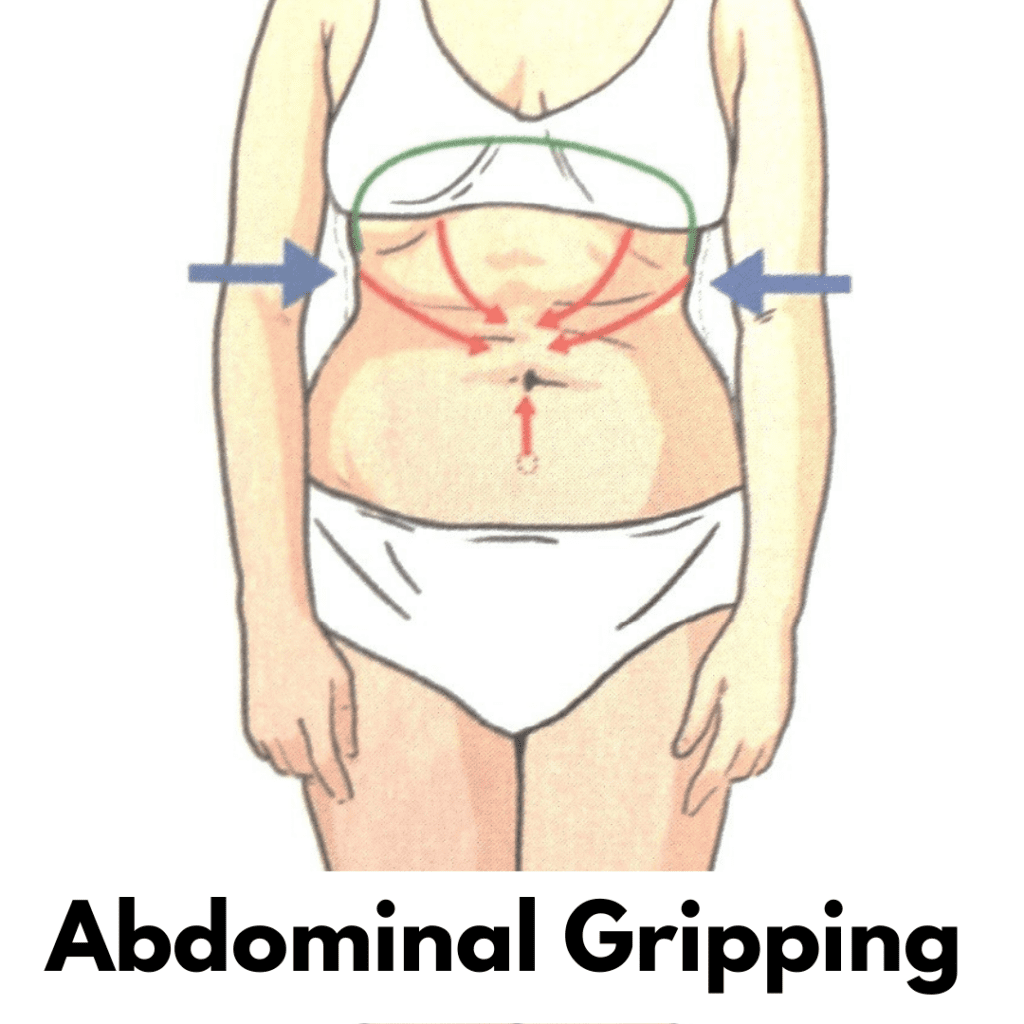
Excessive clenching in either of those two areas is known to lead to low back pain. There is a phenomenon in the body called irradiation. This phenomenon basically means that tension breeds tension. An example of this is if you were trying to lift something heavy with your right arm, and it was difficult, you might clench your left fist really tightly in order to build more strength in your right arm. So basically, creating tension in a nearby area increases the tension in that secondary area.
Increased tension in the abdominal muscles leads to increased tension in the low back muscles which will lead to pain. The same thing happens in the gluteal muscles. Our muscles are meant to work all together. When one group becomes dominant and overactive, this causes tension to increase all around that area.
If you're reading this and you are thinking that you can really relate to those three areas that I talked about above, you're probably wondering, "Well, what can I do about it.?"
There are two main things that need to be done for these problems to improve. The first is: you need to develop strategies for managing stress.
None of us can avoid stress. It's just a part of life. However, that doesn't mean that we just say woe is me and do nothing. So that means, if certain times of our life become more stressful than normal, we'll want to find strategies to mitigate the stress. I will talk about some specially helpful strategies in further blogs.
In conjunction with managing your stress, you want to find ways to alleviate the tension in the areas that are bothering you. Below, I will go over great ways to reduce the tension in the three areas I talked about above.
The contract-relax stretch is shown below. This type of stretch involves activating the muscle first and then stretching it. After a muscle has been activated, it's actually more susceptible to stretch.
2. For the inner shoulder blade muscles, I recommend using a lacrosse ball or trigger point ball.
a) For this, you're just going to go stand with your back against a wall. b) Put a lacrosse ball in between your shoulder blade and your spine. c) Then you're just going to move your torso and bend your knees in order to roll the ball all the way into the muscles in between the shoulder blades.
I recommend 60 to 90 seconds on each side of the spine.
For the jaw muscles, there are two main areas that need to be worked on. These are the jaw muscles, and the upper neck muscles. As I said before, clenching can cause both jaw pain and headaches that tend to be at the base of the skull.
a) The first technique is a release of the tension in your jaw muscles. For this one you're going to take your fingers and find your cheekbones and follow your cheekbones back towards your ear. There are two main groups of job muscles that we want to release. One of them is above the cheekbones and the other one is below.
b) So first, we'll start on the ones above the cheekbones and you'll just move your fingers upwards into the area just in front of your ear. You're going to push your hands inwards like you're trying to go into your skull and then kind of drag the tissue up towards the ceiling. This pins the muscle. Then you're going to slowly open your jaw as wide as you can: this will stretch the muscle. The video below shows the release for the muscle that is above your cheekbones. You would just repeat the same technique in the muscles below your cheekbones.
The image below shows the locations of these muscles so you'll want to do multiple passes with your hands since the muscles are pretty large.
3. The last area are the muscles at the base of your skull. These are the muscles most commonly affected when we clench our teeth. And these are the muscles most commonly associated with tension type headaches.
a) To work on these muscles, you're going to want to get either two tennis balls or two lacrosse balls and you're going to tape them together like the photo below. We call this device a peanut. b) What you want to do is to find a semi-hard surface and lie down on your back. c) Take the peanut and place it just below the base of the skull. d) You don't want the balls actually pushing on the bone of the skull - you want them in the fleshy area just below.
I recommend starting off by lying on this for 4 minutes at a time. Every couple of days, increase that by a minute until you get to 8 minutes. I don't recommend lying on it for longer than 8 minutes.
For the tightness that comes from gluteal muscle tension, we want to stretch out our hip muscles. The video below shows one of the best stretches to relieve tension in these areas.
If you are an abdominal gripper and notice tension in your abs daily ,the technique shown in the video below can be extremely helpful. He uses a much larger ball, but I recommend using a lacrosse ball in the same fashion as he shows in the video.
So there you have it. That darn stress really takes a toll on our body! But now you have some tools to fight back. Try these out and stay tuned for next week when I'll talk about stress management strategies.
And if you're dealing with a lot of pain right now and don't have time to wait for some of this stuff to work on your own, be sure to give us a call at 918-300-4084 and we can help you speed up that process of getting out of pain!


We have all heard that modern life is stressful. News articles talk about stress management, the health consequences of stress, and how to cope with stress. But ... what exactly IS stress?
With the holidays upon us, I wanted to do a deep dive on stress. During the month of December, I'm going to talk about the effects stress has on our bodies, and how to manage the stress we're all under.
In this first blog I'm going to talk about what stress is, what are the different types of stress, and what's the difference between stress and anxiety.
So what exactly is stress?
Stress is any type of change that causes physical, emotional, or psychological strain. Basically stress is your body's response to anything that requires attention or action.
But stress is not always a bad thing. There's actually two different types of stress: distress and eustress.
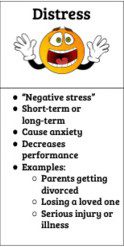
Distress is any stress that has a negative effect on us. It has the following characteristics:
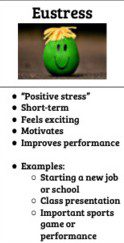
Eustress is any stress that has a positive effect on us. The characteristics of eustress are:
Examples of distress would be things like the death of a loved one, losing your job, or experiencing a significant injury.
Examples of eustress would be things like getting a promotion at work, graduating from school, or winning the lottery.
One important thing to understand is that while both distress and eustress have very different effects on our mental and emotional health, they can both have detrimental effects on our bodies. They both can tax our body's reserves and produce negative physical effects. Stay tuned throughout this month and I'll go over many of the different negative physical effects of stress and what to do about them.
When you hear people talk about stress, it's common to hear them talk about anxiety as well. Those two terms are often presented as if they are the same thing. Stress and anxiety are definitely similar, but they are not the same thing.
What differentiates stress and anxiety is the source of the strain. The source of STRESS is external. This means the strain on the body is from outside. A work deadline, financial obligations, losing a loved one, these are all external factors. If the source of the strain is taken away, the strain goes away. If you complete that work project, the stress of the deadline goes away. If you come into some money, the stress of bills goes away. That is how stress works.
However, with ANXIETY, the source of the strain is internal. You can think of anxiety as what happens inside of us in response to stress. Maybe you start to worry constantly about money when you experience some financial difficulties, or perhaps a loved one dies and you start to become obsessed with the fear of your own death. These are both an internal response to stressors.
The main difference between anxiety and stress is that anxiety can remain long after the actual stressor has passed.
So there you have it. Now you know that there are actually two different types of stress. While their effects can be different, it's important to understand that they both drain the body's resources - so they can have negative effects. You also now know the difference between stress and anxiety. Mainly that stress is an external event and anxiety is how we deal with stress internally.
Stay tuned this month as I will be explaining the effects of stress on the body (You won't believe all the different ways it affects you!), and how to manage stress to reduce its harmful effects.
You are going to learn so much this month! Thanks for taking time out to educate yourself on stress/anxiety and how you can make your own life better by managing them.
Remember, this month often brings various external pressures to bear - and causes stress for a lot of us. We're here for you - we can help balance your body and alleviate some of the effects of that stress. We'd love to see you in our new location! Just give us a call at 918-300-4084

Well - Halloween is fast approaching! As I was thinking about trick-or-treating, it made me think about the tricks that our body can play on us. So, for the month of October, I'm going to be covering the different ways that our body can trick us.
This week we're going to be talking about trigger points. You may have never heard of trigger points before, but you probably have felt them! When our muscles contract, the entire muscle does not contract all at once. If you start with your elbow straight and slowly bend your elbow, your bicep is one of the main muscles that does this action.
However, when you start to bend your elbow, the entire bicep muscle does not contract all at once. At first, the part of the bicep that's closest to your elbow is the only part that contracts, then slowly the middle portion of the bicep will contract, and then when your fist is up next to your shoulder, the upper portion of the bicep will be contracting.
This is how our muscles are supposed to work: Different sections contract depending on what our body is doing at that time - and then they relax when we stop moving that body part. At least that's how it's supposed to work. Sometimes little sections of our muscles will stay contracted even after we've stopped using that muscle. This tiny little section of muscle that remains in a contracted state is usually kind of hard to the touch. If you've ever felt a knot in a muscle, you're feeling a trigger point.
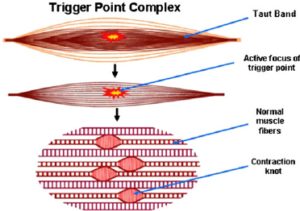
In this blog, I'm going to mention the different types of trigger points, trigger point pain referrals, and the three most common trigger point referrals I see in my patients that try to trick us about where the pain actually is.
There are two types of trigger points:
1) Active trigger points
2) Latent trigger points
If you're walking around and you feel a painful area in a muscle, that is an active trigger point. That means that it's painful at rest. But if you've ever had a massage, and when the massage therapist starts pressing on an area, you find that it's super tender and very painful, but it wasn't painful until they touched it, that is what's called a latent trigger point.
Trigger points are known to produce what is called referred pain. If you have ever heard of the symptoms of a heart attack, specifically the pain down the left arm, this is another example of referred pain. Referred pain is when one specific structure is irritated, but we actually feel the pain in other areas.
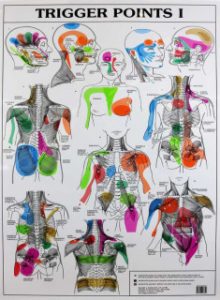
This can be extremely confusing, but it's very important to know if your pain is referred or not. Imagine if you went to the hospital with chest pain and left arm pain, and the nurses just started treating your left arm. You probably wouldn't have a very good outcome.
This is why it's important that your doctor is familiar with the concept of referred pain.
Otherwise valuable treatment time may be wasted on areas that are not actually irritated, but are just the location of referred pain.
The woman who first discovered trigger points created maps of trigger point referral patterns. These maps showed the areas where referred pain is felt for all the different trigger points in all of the muscles of the body.
The three most common trigger point referrals that I see in my practice are:
The gluteus medius muscles are located on the side of both hips. Trigger points in these muscles can send pain down the side and back of the thigh all the way to the back of the knee. Some doctors have called these trigger point referrals pseudo sciatica. Many people with trigger points in these muscles will actually think that they're having sciatica pain/issues, but really, it's just a trigger point.

Above you will see the trigger point referral map for the gluteus medius. It can cause pain around the low back or SI joint and all the way down the thigh to the knee. If you are having pain in these areas, I recommend you get assessed by a doctor who's familiar with trigger points.
__________________________
The infraspinatus muscle is on the back of the shoulder. However, the trigger point referral actually wraps around to the front of the shoulder. Sadly, I have seen patients who had surgery on the front of their shoulder - and their pain didn't change at all. It was only after treatment to the infraspinatus on the back of the shoulder that their pain went away.
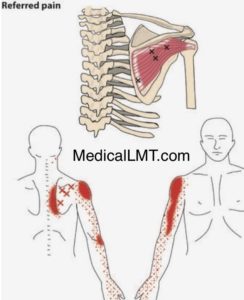
Above you'll see the trigger point referral map for the infraspinatus. It can cause pain along the inner shoulder blade area, the front of the shoulder, and down the bicep. If you've had pain in these areas and maybe even have had some treatment with no help, make sure to see a doctor who's familiar with trigger points.
_________________________
And finally, there is the thoracic erector spinae. The erector spinae muscles are the muscles that run up the spine very close to the bones of the spine. These are the muscles that help us stand up tall. In the thoracic region or mid-back, trigger points in these muscles can actually refer pain to the low back and tailbone. I will often see patients who complain of low back pain and have had lots of adjustments to the low back and pelvis with no improvement. Once we treat the erector spinae, their pain goes away.
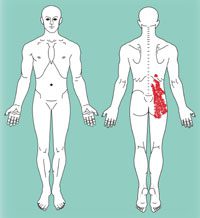
Above, you can see the trigger point referral map for the thoracic erector spinae. Interestingly, you can see that the pain referral map is almost completely in the low back. Meaning: You might not have any pain in your mid back, but that's actually where your problem is. These muscles can refer pain down to your low back tailbone and even the back of your hip. If this is a problem area for you - again - please make sure to see a doctor who's familiar with trigger points.
So there you have it, our body can really try to throw us for a loop. This is why it's always good, when you're in pain, to get a proper evaluation by a doctor who will look at all areas of the body and not just where you're hurting. This is something we do with every patient here at Movement Laboratory. If you're hurting and you suspect that you might have some referred pain going on or any other type of pain, give us a call at 918-300-4084 and we'll help you get out of pain fast!
Tune in next week when I'll discuss how some of our internal organs can cause pain all across our body!

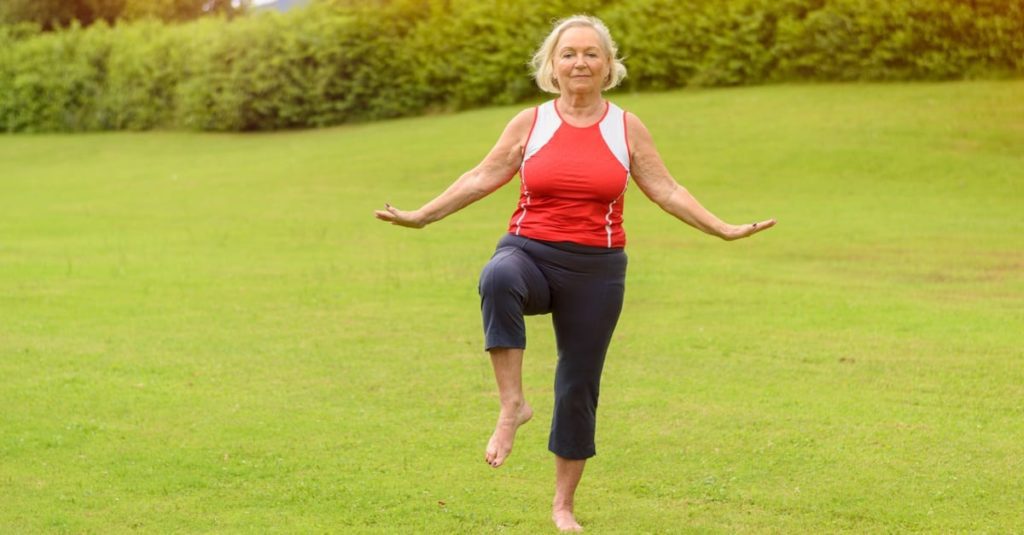
I've gotten a lot of feedback and questions about the feet in the last few weeks after I published my blogs on bunions. This week I wanted to talk about why our feet are so important for our overall health and wellness.
Our feet are literally our foundation.
They are the first thing that contacts the floor once we stand up and become weight-bearing. In addition to housing and maintaining the function of the muscles and joints that exist in our feet, there are also lots of nerves in our feet. Those nerves carry information to our brain and spinal cord that informs our brains about the structures of the environment around us.
If we are walking uphill, the nerves in the feet sense the stretch in the bottom of the feet from the hill and they begin to turn on the muscles that we use to raise our leg as we walk up the hill. If we are on uneven terrain, the nerves in the feet send messages to the brain and spinal cord that activate the stabilizing muscles in our hips that help to support us on uneven surfaces.
This is part of what makes the feet so important. As they encounter the ground around us, our feet send messages that help the rest of our body prepare for the environment that we are in. This is one of the reasons for the minimalist and barefoot trend emerging over the last 5 to 10 years. Much of our common footwear these days does not allow our feet to flex and bend and splay with the changes in our terrain. That limits the information coming in from the feet and makes our ankle, hip, and core muscles less able to anticipate the needs of the body.
Tightness in the feet and ankles can also limit this information. That is why foot and ankle mobility is so important. If your foot and ankle cannot bend and twist and splay, then those messages never get to the brain and spinal cord.
So this means there are two needs that our foot and ankle have to properly get our body ready to move.
In this blog, I will discuss how to make sure your foot and ankle get good exposure to the environment.
In my next blog, I will be going over how to make sure your foot and ankle have proper mobility.
The best way to make sure that your foot is able to sense the ground and the environment around you is to make sure that your footwear allows this to occur. This is why I recommend minimalist shoes for most feet.
When Minimalist shoes first came out, cushioning was thought to be bad, no matter what. And in my opinion, this is what caused many people to dislike minimalist shoes. Let's face it: If you are a marathon runner -- you're going to need some cushion. Thankfully, now minimalist shoes come with a wide range of features.
My recommendations for good Minimalist shoes for everyday use are the New Balance Minimus line, the Merrell vapor gloves, and splay shoes. These are really good shoes for going to work, working out, or walking or hiking. The links to find these shoes are below.
If you're looking for good Minimalist shoes for endurance sports like running, trail running, or long distance walking, I recommend Altra shoes and Topos. These are great foot-shaped shoes with no build-up in the heel and with good cushioning. The links to these shoes are below.
These shoes are a great first step to getting the most out of your foundation.
Additionally - and actually very importantly: I also recommend just walking barefoot in the grass as often as you can. Wake those feet up! Your body will thank you!
And remember, you can always check with me here at Movement Laboratory about any of your foot questions ---we're here at 918.300.4084 or dr.john@movlabtulsa.com.
Be sure to watch for my next blog about ensuring MOBILITY of your feet. It's a critical issue - and there are things you can do to increase your ability to move well on your feet!

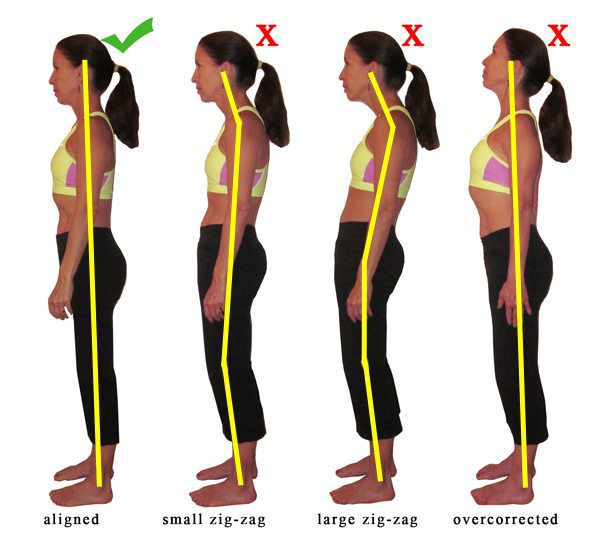
In today's world, we've pretty much learned that a functional core is vital to how our body performs. Many of the aches and pains that are common can be linked to an improperly functioning core. But what you may not know is that proper posture is a big player in how well your core functions.

Our core is functionally a cylinder. It has cylindrical walls and a roof and a floor. The walls of our core are the deep abdominal muscles in the front and sides and our spinal muscles in the back. The roof of the core is our diaphragm. The floor of the core is our pelvic floor muscles. The picture above illustrates this.
In order for the core to function properly, the walls, roof, and floor must all be aligned properly. The purpose of our core is to do two things: Our core attaches the top part of our body to the lower part, and it creates something called intra-abdominal pressure.

Intra-abdominal pressure is vital for proper core function. To picture what intra-abdominal pressure does, you need to imagine blowing up a balloon as much as you possibly can. Then imagine grabbing the balloon from the top and the bottom and trying to twist it or fold it over on itself.
If it's completely full of air, this will be difficult. But imagine you let a little bit of air out. Now it's easier to twist and bend that balloon.
The same concept applies to the core. When we have good intra-abdominal pressure, it helps to stabilize our spine and make it hard to bend and twist. This is important when we're lifting heavy things to help keep our spine safe. When we don't create intra-abdominal pressure well, our spine is vulnerable.
The roof has to be stacked directly over the floor. In regards to posture, this means that your diaphragm needs to be stacked directly over your pelvic floor. Your diaphragm is attached to your rib cage and your pelvic floor is attached to your pelvis. So, if your rib cage or pelvic posture is not ideal, then you are at a disadvantage for creating intra-abdominal pressure.

Many people have what's referred to as "open-scissors posture." This is when we have a little bit of an excessive arch in our low back that causes our rib cage to be tilted backwards and our pelvis to be tilted forwards. This creates really bad alignment and hinders the creation of intra-abdominal pressure. The picture above shows the open-scissors posture.
The video below shows the proper postural alignment and how to put your body in the best position to enable your core to function.
The exercises below are great to help make those postural corrections permanent. Remember to start these exercises with proper alignment.
It's easy to see how your Posture affects your Core!
And there you have it. Now you have some great tips for how to align your body to get better core function. If you are reading this blog because you have pain related to poor core function, we can help! Just come see us at Movement Laboratory to experience the MovLab Difference!
Using Chiropractic care and specific therapeutic exercises, we get people out of pain and back to what they love FAST! Call us at 918-300-4084 to schedule your appointment today.

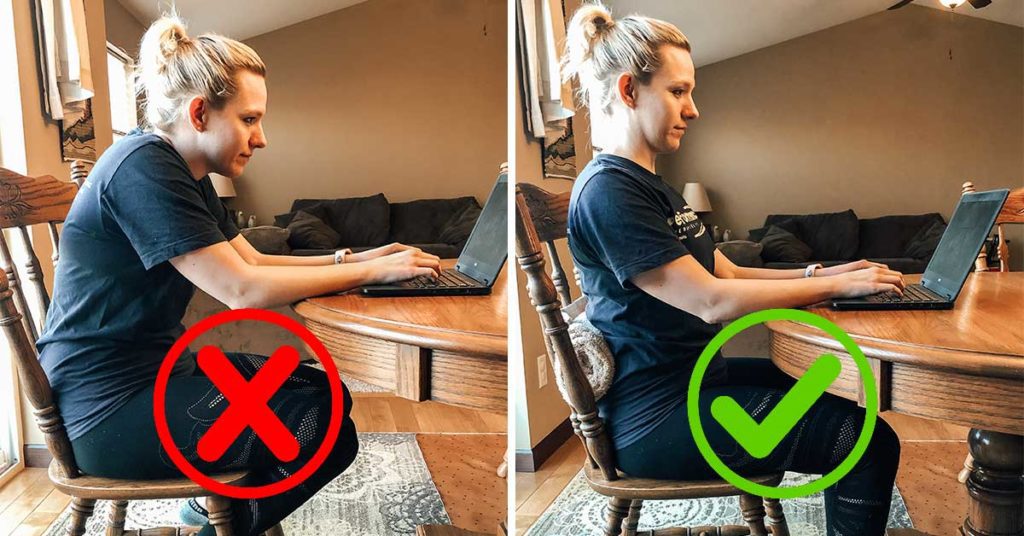
When your low back is hurting, sitting can be a rough proposition. This is because sitting puts a lot of pressure on your low back. Sitting incorrectly can make work or other tasks that require long periods of sitting a very painful experience. In this blog, I want to introduce some simple tips to greatly reduce your pain from sitting.
The bottom of your pelvis has two thickened pieces of bone that are designed to support your weight. These are called the ischial tuberosities or more commonly referred to as our "sit bones". The picture below shows these bones.
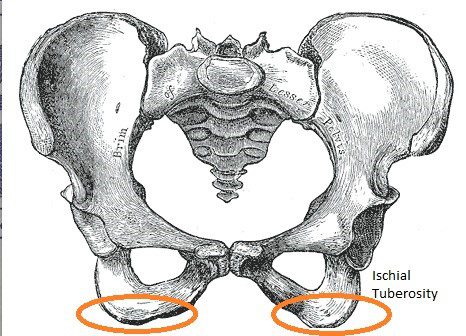
The problem is many of us don't actually sit on our sit bones: Instead, we sit on our tailbones. Doing that puts a lot of pressure on our low back and can be a big contributor to pain when sitting and after sitting. When you slouch while sitting, you're shifting the weight off of your sit bones and back to your tailbone.
If you have low back pain when sitting, pay attention to that! Make sure to rearrange yourself. Sit up tall and find that neutral sitting position that makes you feel like your weight is resting on your sit bones. The picture below shows the right way to sit and the wrong way.
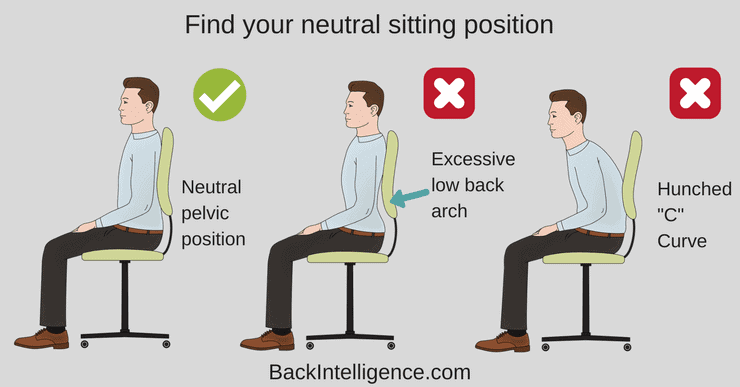
In order to find this important neutral position, sit in your chair, slouch and let your pelvis roll backwards, then roll your pelvis the opposite way by excessively arching your back. These are the two extremes. Then find the middle point between these two positions and that is your neutral. Sitting in neutral will greatly reduce low back pain.
The discs in your low back are under different amounts of pressure throughout the day. Some positions put minimal amounts of pressure on your discs and some put a lot of pressure on your discs.
We all have to sit at some point in our lives. Some jobs require a lot of sitting. We can't avoid sitting. But we can break it up.
Research has found that taking breaks from sitting can reduce pain from sitting. That same research has found that it's the quantity of breaks that makes the most difference - not the length of the breaks. So its better to take a 10-second break every hour than to take a 30-minute break every three hours.
I recommend taking a break every 50 minutes. This break can be 10 seconds or 5 minutes.
The bones of your low back have three joints with every bone above and below them.
When your low back is leaned forward, such as when you slouch, the weight is shifted forward so that your disc joints bear most of the load.
When your low back is hurting, putting most of the weight on your discs is not a good idea.
When you instead have a backwards curve in your low back, the weight is shifted backwards towards the facet joints. Creating that backwards curve as you sit can greatly reduce the pain in your low back. The picture below shows these joints.

Lumbar supports are devices used to help shift the weight more towards the facet joints so the discs are not bearing all the weight. If sitting upright and taking sitting breaks still leaves you with lots of low back pain when sitting, then you need to try adding a lumbar support.
I recommend what's called a lumbar roll. The picture below shows one of these devices. The device can be strapped to any seat, so you can take it with you from your work chair to your car and to your couch at home. The picture below shows a lumbar roll.
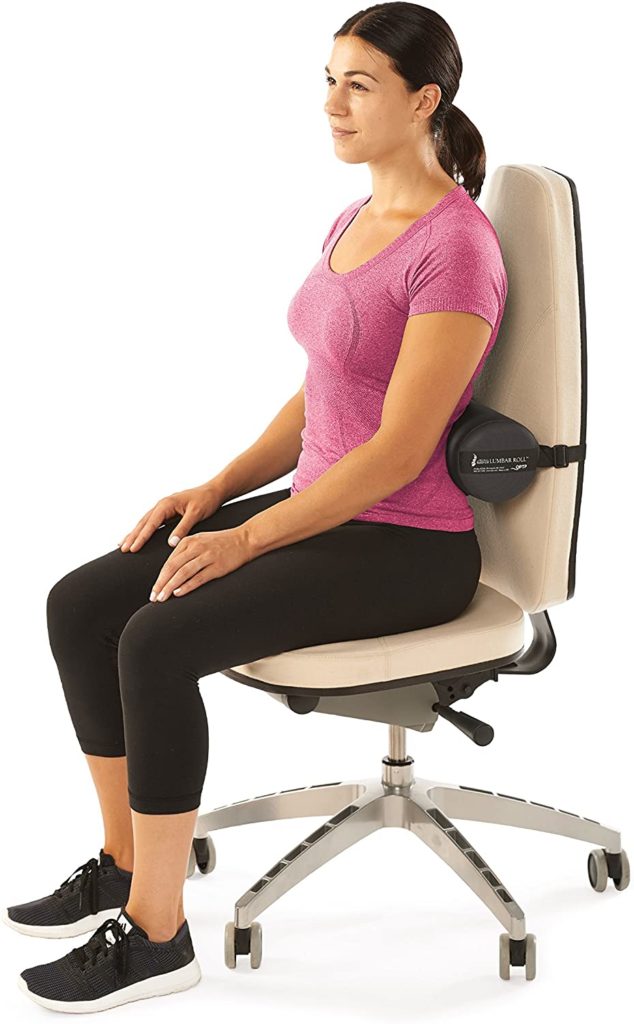
You want to make sure you place it correctly for it to be most effective. The video below shows how to position it on your back to get the best results.
If posture correction and breaks are not enough for you, try a lumbar roll. Make sure you use it every time you sit for 3-4 weeks and you should notice a significant decrease in your low back pain when sitting.
So there you have it. 3 simple tips that will make a big difference in your low back pain when sitting.
If you want some help to make that back pain a thing of the past, come see me at Movement Laboratory at 92nd & Sheridan. Most of our low back pain patients get 80-100% improvement in their pain in just 3 weeks!
If that sounds good to you, give us a call at 918-300-4084.

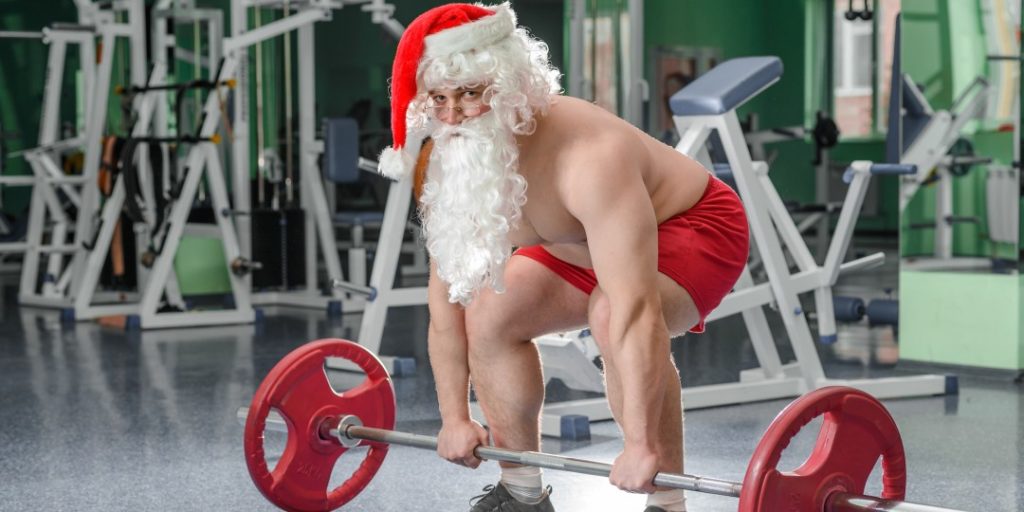
Lifting ... It's the most common cause of low back injury. And low back pain is the most common cause of disability in the United States. So it's really important that you lift correctly!
There are lots of sayings like, "Lift with your knees, not with your back," - and they are mostly right. But the one that I like the most is the title of this blog! "Lift with your butt, not with your back."
Did you know that your butt muscle, the gluteus maximus, is the largest muscle in your body?! It was made, in part, for lifting heavy things. In contrast, your low back muscles are actually pretty small in comparison. Clearly, our bodies were designed to lift heavy things using our butts.
In this blog, I'm going to go over 3 tips to make sure you're lifting with your butt and not your back.
The general rule of thumb in lifting is this:
Whatever body part you bend to get down to pick up the weight is used to lift it up.
So the key to sparing your spine when you're lifting is to just not bend it in the first place.
There are three basic movement patterns that we use to lift things from the floor, whether in daily life or at the gym. These movement patterns are the squat, the lunge, and the hip hinge.
Doing these movements correctly involves maintaining a neutral spine. While the hips and knees bend, the spine stays neutral and tall. Below, you will find videos demonstrating the proper body alignment when doing these three movements.
The main muscle groups that we want to use when we're bending and lifting are on the back side of the body. In order to load these muscles and make sure that they are the dominant ones used when lifting something heavy, you have to make sure that your body does what's called a posterior weight shift.
This means that your center of gravity shifts backwards in order to stretch the muscles on the back side of the body so that they can then be used to lift whatever you're lifting.
To do this, you want to make sure that you feel the weight of your body in your heels and not up at the balls of your feet. Watch the video below to find out how to get your weight in your heels.
Many of us over-rely on our back muscles when lifting. At the top of a lifting motion, you want to feel a strong abdominal contraction and butt muscle contraction. This means your hips are doing the lifting. If you bend over to lift something, and as you raise back up, you feel a strong contraction in your low back muscles, this means you are not using your hips.
You want to focus on using the hip muscles to do the lifting. The video below shows how to do this.
So there you have it. We will all be lifting presents, kids, decorations, etc. in the next few weeks. If you want to make it through without hurting your low back:
"Lift with your butt - not with your back!"
If you read this too late and you are already hurting, give us a call at Movement Laboratory at 918-300-4084. Schedule an appointment today to get out of pain fast!

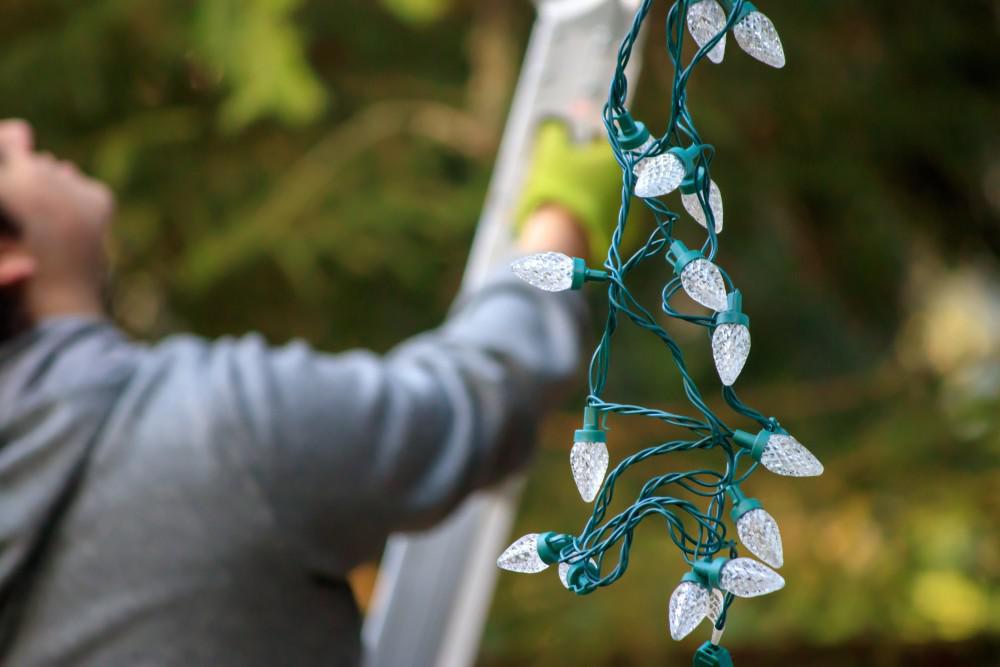
The holidays can be an amazing time. We often get to see family, we make time to get together with others and share our lives, and we get to share gifts with those we love. However, the holidays can also be a difficult time when we're in pain. If pain prevents us from participating in the holiday festivities, that can make us feel distant from those around us.
It's a tough thing to not be able to join in with the family and share those holiday activities. Low back pain is often one of the most common issues that people deal with during the holidays, and it can prevent us from being able to jump right in and share in the making of memories.
This season may require a lot of work. There's putting up those lights and decorating the front of the house, decorating the inside of the house, preparing the meal, wrapping gifts, and many other manual tasks. They can provide a lot of strain to the low back. If you were already in pain, this additional activity can flare up that situation. But also, even if you were not in pain before, the work of getting ready for the holidays can make your low back hurt all by itself. But don't lose hope! I'm going to share three awesome tips with you to help you avoid low back pain during this holiday season.
Getting ready for the holidays can require lots of bending and lifting. Whether it's setting up the decorations, getting food prepared and arranged, or picking up those precious grandchildren, many of us wind up doing a bunch of bending and lifting that we may not be accustomed to doing.
Bending and lifting is a known cause of low back pain if done incorrectly. So in order to get through your holidays without a low-back flare-up, you want to pay close attention to your form when bending or lifting.
The largest muscle in our bodies is the gluteus maximus. These are your butt muscles. Right next to those muscles are your hamstrings. These are also big strong muscles. When you bend and lift anything, take care to ensure that you are relying mostly on your glutes and hamstrings to lift -- and not your back muscles.
In order to set these muscles up to do the work when bending or lifting, you have to pay attention to your posture. When you bend down to lift something up, if you bend your spine too much, you have to use the muscles in your spine in order to come back up from the bend. So instead of bending with your spine to lift something up - take care to instead bend with your hips and knees. This motion is called a hip hinge.
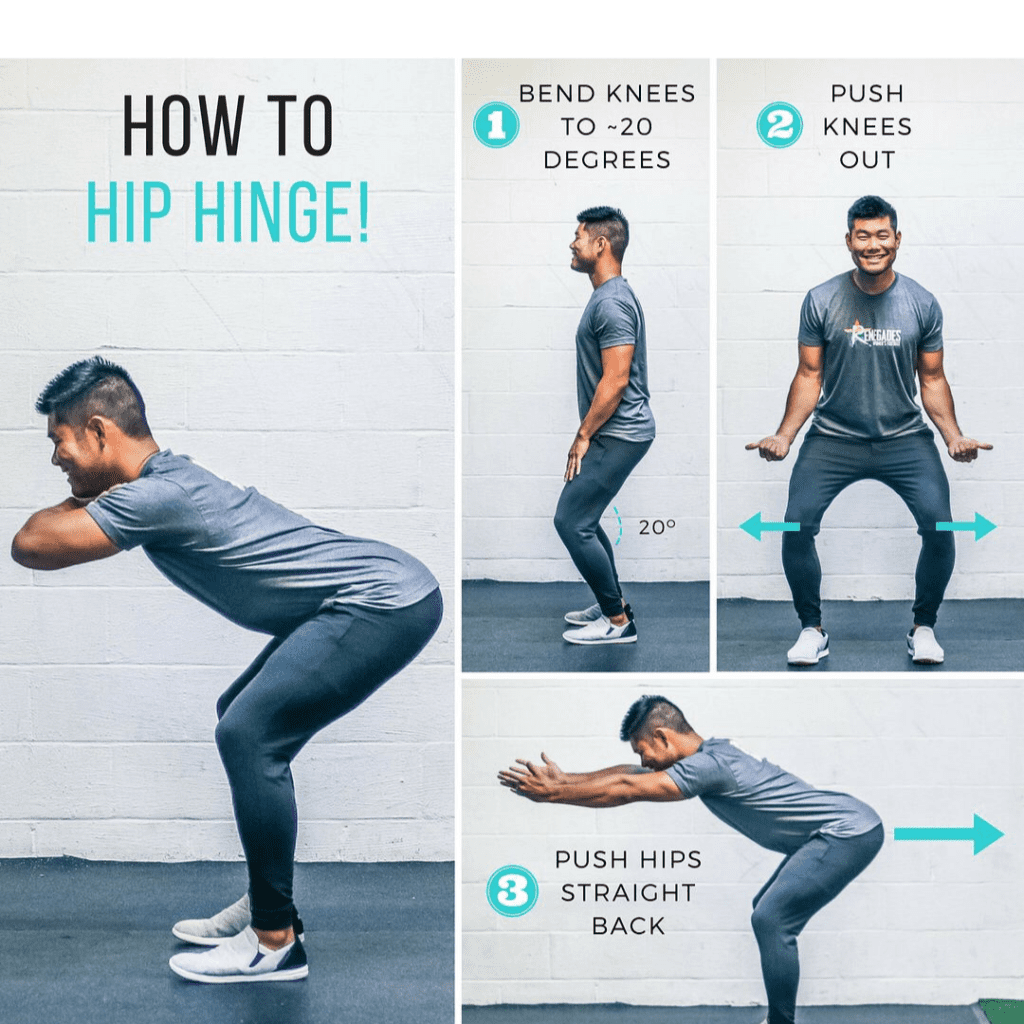
To hip hinge properly you want to keep your spine tall and long and sit back through your hips like you were looking for a chair with your back pockets. This will ensure that your hips and knees bend which will load your gluteus maximus and hamstring muscles. This will ensure that when you go to lift and stand back up that those muscles will be the ones that do the work.
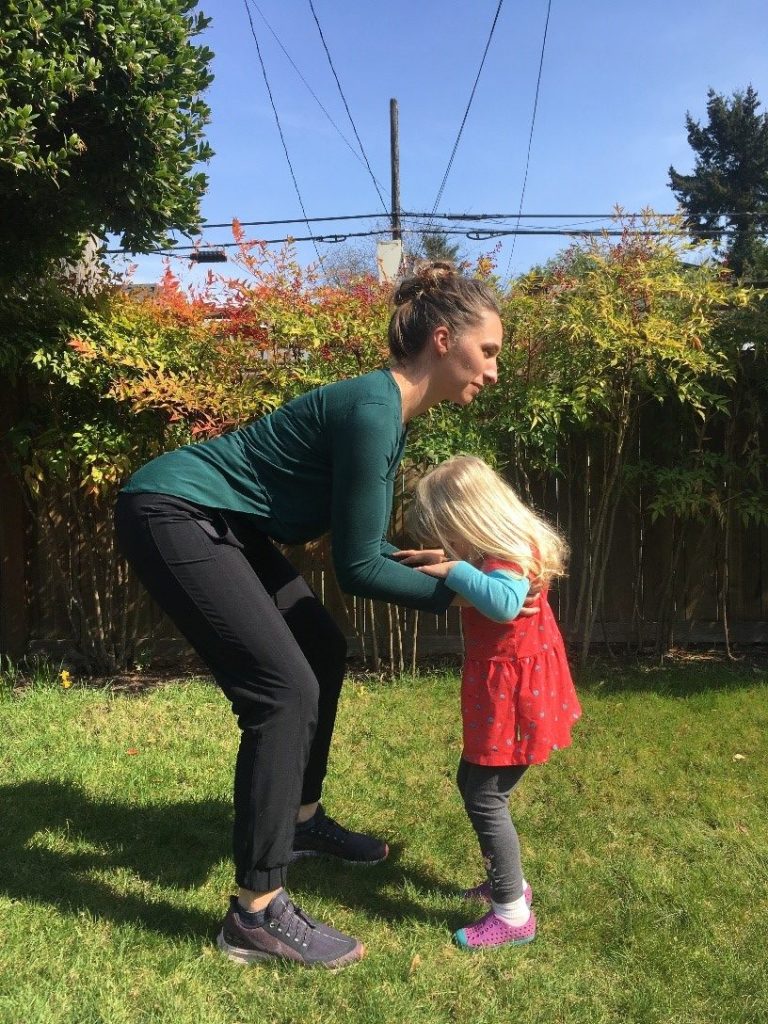
So -- every time you bend down to pick up a child during the holidays, or pick up a heavy gift, or work on some decorations, use the hip hinge in order to spare your spine during the holidays!
A large majority of the low back pain that we suffer from is in some part caused by the discs in our low back. When our discs become irritated, that leads to aching in our low back that can sometimes go down into the back of our hips and thighs. Irritated discs can cause tightness and spasm in the muscles around our low back, and sometimes - if the discs become swollen and bulge - they can press on our nerves and cause pain to run all the way down the legs.
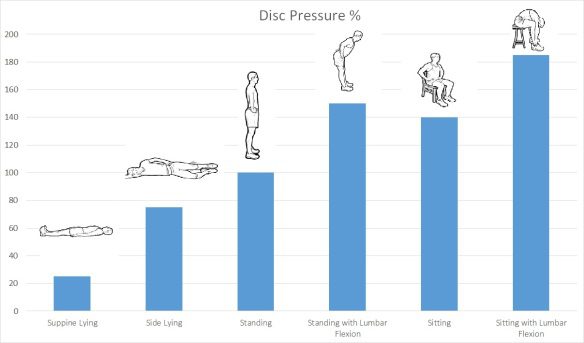
The amount of pressure that our discs experience is influenced by our postures. When we're lying down, our discs experience very low amounts of pressure. When we're standing, that pressure goes up. But the highest amount of pressure that our discs experience is when we sit. So in order to avoid low back pain during the holidays, you will want to try not to sit for long periods of time.
I recommend sitting for no longer than 50 minutes at a time. It's been shown that the frequency of your sitting breaks is more important than how long those breaks are. So set a timer in your phone if you need to and make sure every 50 minutes you stand up for at least 10 seconds.
This will make a huge difference in reducing the irritation to your low back during the holidays!
If you're already dealing with low back pain before the holidays even start, the most important tip is to be proactive. 80% of low back pain is a type of low back pain called flexion intolerant low back pain. This means that our already-injured tissues are irritated when we bend our spine forward.
This is why most of us have pain when we have to bend or lift while our low back is already hurting. But an important fact is that while bending forward will make our low back hurt worse, bending backwards actually helps to reduce the pain and reduce the other symptoms related to the low back pain and including sciatica pain.
So if you're already having pain before the holidays start, you need to do this exercise shown above.
I recommend doing sets of 10 as noted below. Per the video above, you will lie on the floor leaving your hips on the floor, and press your chest up until your elbows are straight. The keys here are to make sure that your butt muscles and your back muscles are relaxed so that your spine bends backwards as much as possible.
If you can do 10 of these every 3 to 4 hours that you're awake during the holidays, you'll find that you will greatly reduce the pain in your spine and lessen the symptoms of sciatica. Below we provide a standing version of this exercise in case it's difficult for you to get down on the floor.
So there you have it. Three tips to help you greatly reduce low back pain during the holidays.
Give them a try to ensure that you won't be left out of any holiday activities this season!
And if you need additional help with pain during the holiday season, make an appointment and come see us here at Movement Laboratory. We offer patient-centered and personally tailored plans that can help you get out of pain quickly and get back to enjoying the holidays of 2021 - and get you started off right into 2022!
Give us a call at 918-300-4084 and say goodbye to pain during the holidays!
